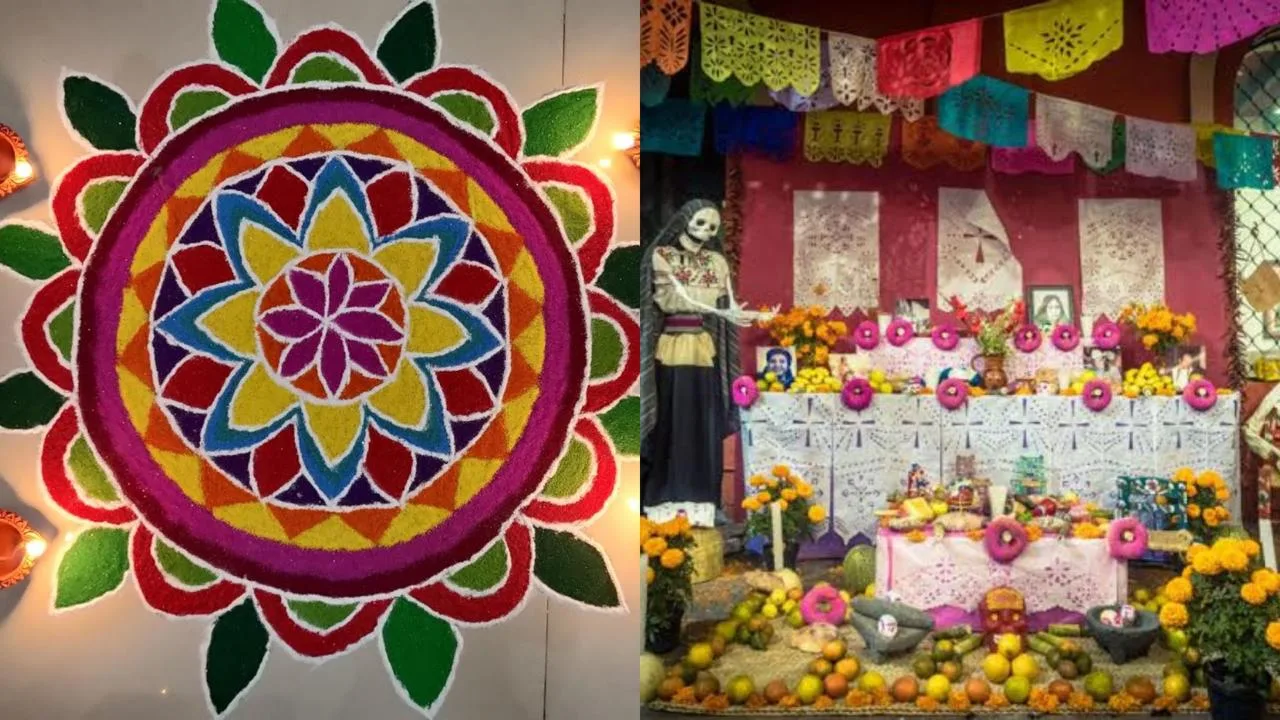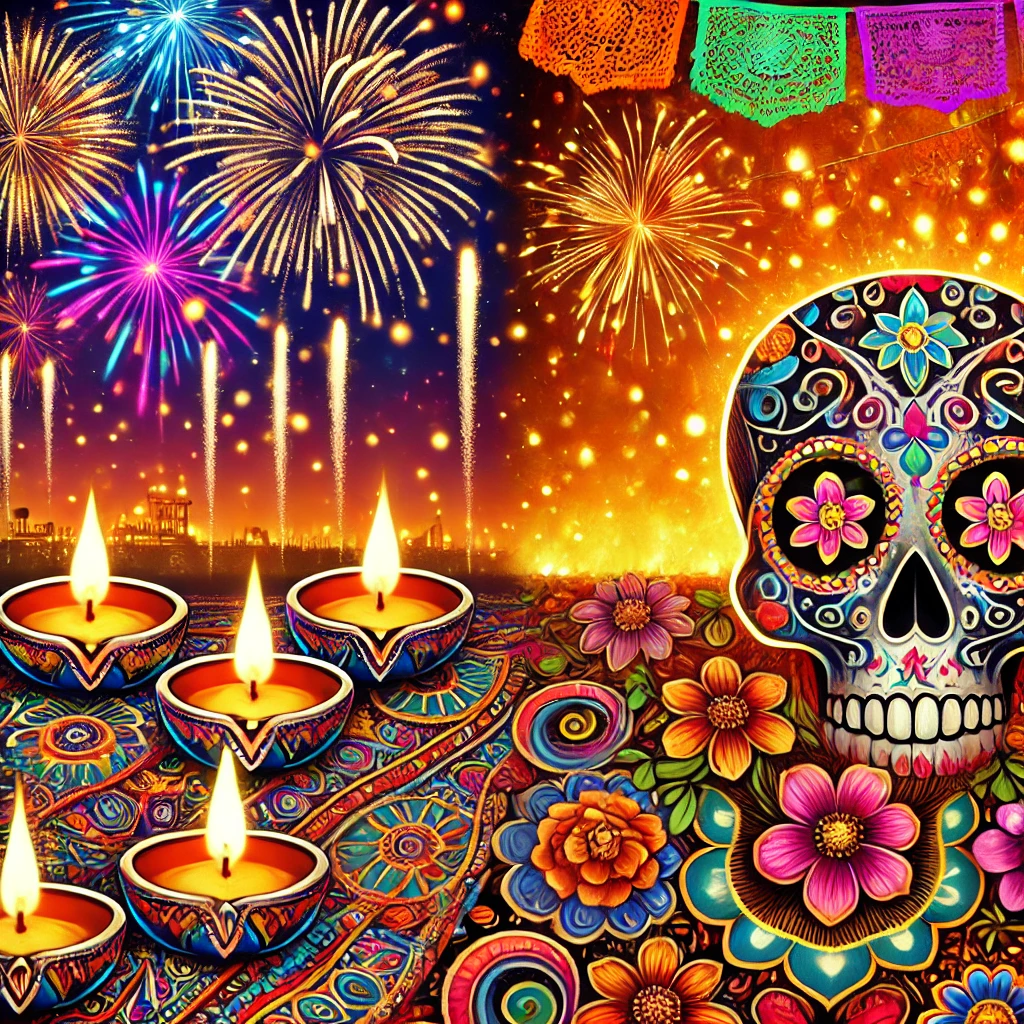Globally, diverse communities observe sacred times of the year with rituals, gatherings, and celebrations. Two such globally recognized festivals are Diwali in India and Día de los Muertos in Mexico. Though originating in distinct cultural and geographical contexts, both share striking similarities in their underlying themes of light, the remembrance of ancestors, and the celebration of life and death. Let’s uncover the shared human experience that transcends cultural and national boundaries.
Diwali and Día de los Muertos have deep-rooted origins, going back centuries. While they stem from different religious and cultural traditions, they are grounded in a respect for life’s cyclical nature and a reverence for the divine.
Diwali, also known as the “Festival of Lights,” is one of the most significant festivals, celebrated across India and by millions around the world. Traditionally linked to the return of Lord Rama to his kingdom Ayodhya after defeating the demon king Ravana, Diwali symbolizes the triumph of good over evil and light over darkness. Its historical roots are anchored in Hindu mythology, but it is also observed by Jain, Sikh, and Buddhist communities for various reasons, always celebrating the victory of light and purity.
Día de los Muertos (Day of the Dead), celebrated primarily in Mexico, dates back to pre-Hispanic indigenous traditions, particularly among the Aztec and Nahua peoples, who believed in a cyclical view of life and death. The festival was originally a month-long celebration dedicated to the goddess Mictecacihuatl, the “Lady of the Dead.” After Spanish colonization, the festival blended with Catholic traditions while retaining its indigenous significance of honoring ancestors and deceased loved ones.
Celebrated during the Autumn months
Both occur in autumn, a season often associated with harvest and the end of the agricultural year. This period symbolizes transition: from light to darkness, from life to death. The timing of the festivals underscores the universal human fascination with the cycles of nature.
Diwali is typically celebrated in October or November, depending on the lunar calendar, on the darkest night of the Hindu month of Kartika. The timing reflects the festival’s themes of light overcoming darkness, symbolically and literally, as oil lamps and candles illuminate homes and streets during the darkest time of the month.
Día de los Muertos falls on November 1st and 2nd, during a time when the veil between the living and the dead is believed to be thinnest. This time of year coincides with Catholic All Saints’ and All Souls’ days, but the roots go much deeper, with indigenous beliefs emphasizing the cyclical nature of life and death.
Role of Light
Light symbolizes a bridge between life and death, reminding the living of the enduring connection with those who have passed on.
In Diwali, the lighting of lamps or diyas is the most iconic ritual. The lamps signify the triumph of good over evil and knowledge over ignorance. Homes, temples, and public spaces are adorned with lights, creating an atmosphere of warmth, hope, and renewal. The brilliance of the illuminated spaces contrasts with the darkness of the night, representing the belief that even in the darkest of times, light can prevail.
On the other hand, Día de los Muertos uses light, particularly candles, to guide the spirits of the dead back to the world of the living. Families set up ofrendas(altars) decorated with candles, flowers, and photographs of their deceased relatives. These candles serve both a practical and symbolic purpose: they light the way for the spirits to find their way home during the night, while also representing the ongoing presence and guidance of the ancestors.
Remembrances of the deceased
One of the traditions observed, especially in Hindu households, is the commemoration of deceased family members during the Pitru Paksha period, which precedes the main Diwali celebrations. Hindus believe that during this time, the souls of their ancestors come down to earth and bless their descendants. Offerings of food and prayers are made to ensure the well-being of these spirits, invoking their blessings for prosperity and happiness in the coming year.
Día de los Muertos, on the other hand, is wholly dedicated to the deceased. Families create altars or ofrendas in their homes and cemeteries to welcome the souls of the dead. These altars are adorned with offerings such as food, drinks, and personal mementos that the deceased enjoyed during their lifetime. The ofrenda becomes a sacred space where the living commune with their ancestors, reflecting the belief that death is not the end, but a continuation of life in another realm.
Food
During Diwali, families prepare a variety of sweets and snacks, such as laddoos, barfis, and jalebis, which are shared with neighbors, friends, and family members. These sweets are also offered to deities as part of the religious rituals, symbolizing the hope for sweetness and prosperity in the coming year. The act of giving and sharing food is central to Diwali’s message of community and goodwill.
Similarly, during Día de los Muertos, food plays a vital role in the celebration. Traditional offerings on the ofrendas include pan de muerto (a sweet bread baked in the shape of bones), sugar skulls, and the favorite foods of the deceased. These offerings not only serve to nourish the souls of the departed but also reflect the communal nature of the festival, where families and communities come together to celebrate life, death, and the continued presence of their loved ones.

Use of colors
Diwali is famous for its use of bright colors in the form of rangoli (intricate patterns made with colored powders or flowers) that adorn the entrances of homes. These patterns are believed to welcome good luck and prosperity.
In Día de los Muertos, vibrant marigold flowers (known as cempasúchil) are used to decorate altars and graves. The bright orange and yellow hues of the flowers are believed to attract the spirits of the dead to their families. The colorful sugar skulls and the painted faces of celebrants are also iconic elements of the festival, representing the fusion of life and death in a celebratory and respectful manner.

Philosophical reflection on life, death, and the human condition
While Diwali and Día de los Muertos arise from different cultural and religious traditions, they share many commonalities in their celebration of life, light, and ancestry.
Diwali’s emphasis on the triumph of light over darkness can be seen as a metaphor for the human soul’s journey toward enlightenment and self-realization. The festival reminds participants that despite the challenges and sorrows of life, there is always hope and the possibility of renewal.
In Día de los Muertos, death is not seen as an end, but as a natural part of life. The festival teaches that the dead continue to live on in the memories and hearts of their loved ones. By celebrating death, Día de los Muertos invites the living to embrace the inevitability of mortality and to find comfort in the enduring presence of those who have passed away.
